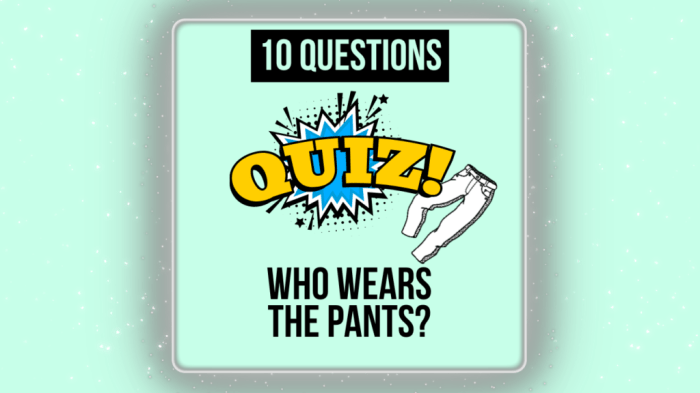Embark on a journey of discovery with our captivating “Who Wears the Pants in the Relationship Quiz.” This insightful tool delves into the intricacies of power dynamics within relationships, shedding light on the complex interplay of gender roles, communication styles, and cultural norms.
As you navigate the quiz, you will gain a deeper understanding of how power is distributed in your own relationship, empowering you to make informed choices and foster a more equitable and fulfilling partnership.
Understanding the Concept of “Who Wears the Pants” in Relationships

The phrase “who wears the pants” has its roots in historical and cultural contexts, often referring to the traditional gender roles where the man is perceived as the dominant figure in a relationship. In modern relationships, the interpretation of “wearing the pants” has evolved, encompassing various power dynamics and decision-making patterns.
The distribution of power in relationships can manifest in different ways, including traditional gender roles (man wears the pants), egalitarian relationships (shared power), and female-led relationships (woman wears the pants).
Factors Influencing Who Wears the Pants: Who Wears The Pants In The Relationship Quiz

Gender Roles and Expectations
Gender roles and societal expectations can shape the power dynamics in relationships. Traditional gender norms often dictate that men are expected to be the breadwinners and decision-makers, while women are responsible for domestic duties and childcare.
Personality Traits and Communication Styles
Personality traits and communication styles also influence who wears the pants. Dominant or assertive individuals may naturally take on leadership roles, while passive or less assertive partners may defer to their counterparts.
Cultural and Societal Norms
Cultural and societal norms play a significant role in shaping power dynamics. In some cultures, male dominance is more prevalent, while in others, gender equality is more widely accepted.
Relationship Stage and Duration
The stage and duration of a relationship can also impact who wears the pants. In the early stages, one partner may have more influence due to factors such as age, experience, or financial stability. As the relationship progresses, power dynamics may shift or become more balanced.
Benefits and Challenges of Different Power Dynamics

Traditional Gender Roles (Man Wears the Pants), Who wears the pants in the relationship quiz
Benefits:Clear roles and responsibilities, potential for stability and predictability.
Challenges:Can lead to inequality, resentment, and lack of emotional intimacy.
Egalitarian Relationships (Shared Power)
Benefits:Shared decision-making, mutual respect, and emotional closeness.
Challenges:Potential for conflict if consensus cannot be reached, may require more negotiation and compromise.
Female-Led Relationships (Woman Wears the Pants)
Benefits:Can challenge traditional gender norms, empower women, and promote equality.
Challenges:May face societal disapproval or stigma, can lead to power struggles if the man feels threatened.
Impact on Relationship Dynamics
Communication and Conflict Resolution
Power dynamics can influence communication patterns and conflict resolution. In relationships where one partner wears the pants, communication may be more hierarchical and less open.
Decision-Making and Problem-Solving
Who wears the pants often determines who has the final say in decision-making and problem-solving. Traditional gender roles may lead to the man making major decisions, while egalitarian relationships may involve joint decision-making.
Emotional Intimacy and Support
Power dynamics can impact emotional intimacy and support. In relationships where one partner has more power, the other partner may feel less valued or heard.
Clarifying Questions
What is the purpose of the “Who Wears the Pants in the Relationship Quiz”?
The quiz aims to provide insights into the power dynamics within a relationship, helping individuals identify the factors that influence decision-making and communication patterns.
How can the quiz results be used?
The results can serve as a catalyst for discussions about power dynamics, enabling couples to explore areas for improvement and cultivate a more equitable partnership.
Is the quiz suitable for all types of relationships?
Yes, the quiz is designed to be inclusive and applicable to diverse relationship types, regardless of gender, sexual orientation, or cultural background.